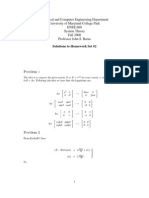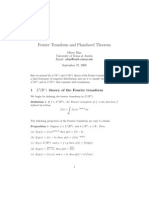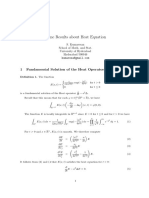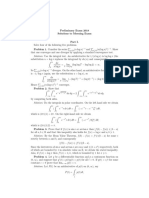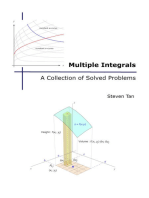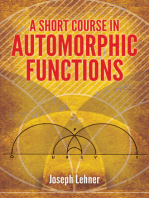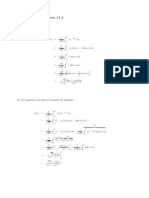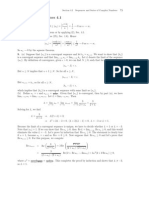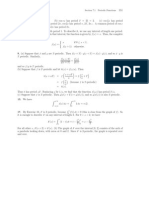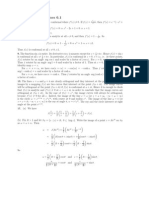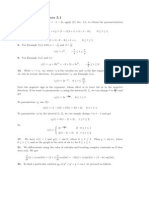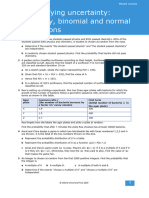Mathematical Techniques III (PHY 317) Answers For Exercise Class 8
Uploaded by
Tri Phương NguyễnMathematical Techniques III (PHY 317) Answers For Exercise Class 8
Uploaded by
Tri Phương NguyễnMathematical Techniques III
(PHY 317)
Answers for Exercise Class 8
Answer to Exercise 1.
Let us consider the function
f(t) = e
t
2
/2
.
By denition, its Fourier transform is given by
f() =
1
2
_
e
t
2
/2
e
it
dt .
In order to perform this integral we complete the square in the expo-
nential:
2
t
2
it =
2
_
t
2
+
2i
t
_
=
2
_
t +
i
_
2
2
2
.
Therefore,
f() =
1
2
e
2
/2
_
e
(t+i/)
2
/2
dt .
To perform the integral we interpret it as a limit
lim
e
(t+i/)
2
/2
dt
and think of the integral for nite as the parametrised contour integral
_
e
z
2
/2
dz ,
where
is the contour parametrised by z(t) = t +i/ for t [, ].
In order to compute this integral, let us consider the closed contour
,
obtained by adding three line segments to
, as shown below:
+ i/
+ i/
6
-
?
The integrand exp(z
2
/2) is entire, so that by the integral theorem,
_
e
z
2
/2
dz = 0 .
1
This implies that
_
e
z
2
/2
dz =
_
_
e
z
2
/2
dz .
We now claim that the integrals along
vanish in the limit .
Indeed, notice that
is parametrised by z(t) = it/ for t
[0, 1]. Therefore,
_
e
z
2
/2
dz =
_
1
0
i
e
(it/)
2
/2
dt
=
i
2
/2
_
1
0
e
it+
2
t
2
/2
dt .
But now notice that
_
1
0
e
it+
2
t
2
/2
dt
_
1
0
e
it+
2
t
2
/2
dt =
_
1
0
e
2
t
2
/2
dt e
2
/2
,
whence
e
z
2
/2
dz
||
2
/2
e
2
/2
,
which goes to zero as . In summary,
lim
e
z
2
/2
dz = lim
e
z
2
/2
dz .
Along
, z(t) = t, so that
lim
e
z
2
/2
dz =
_
e
t
2
/2
dt .
This integral is elementary to perform: we let u =
_
2
t, so that
_
e
t
2
/2
dt =
_
2
e
u
2
du =
_
2
.
Therefore putting it all together,
f() =
1
2
_
2
2
/2
=
1
2
e
2
/2
.
2
By denition, the Dirac delta function is the Fourier transform of 1.
Therefore since lim
0
f(t) = 1 for all t, the limit 0 of its Fourier
transform
f is the delta function. This gives a way to construct func-
tions which approximate the delta function: simply by considering the
Fourier transforms of functions which approach the constant function
1.
This exercise contains the mathematical underpinning of the Heisen-
berg uncertainty principle. The Fourier transform relates the position
x and momentum p representations of the quantum mechanical Hilbert
space. If we prepare a gaussian state in the x representation of the
form
(x) e
x
2
/2
,
in the momentum representation, the state has the form
(p) e
p
2
/2
.
In other words, the widths of distribution are inversely proportional,
so that roughly speaking x p is a constant. Therefore the more
peaked our initial state around a given x, the wider the momentum
distribution, and viceversa. In the limit that the state is concentrated
at a single point (the delta function), all momenta are equally likely:
the constant function 1.
Answer to Exercise 2.
Parsevals identity tells us that the Fourier transform preserves (up to
a constant factor) the square norm of the function:
1
2
_
|f(t)|
2
dt =
_
f()|
2
d .
The proof is simple:
_
f()|
2
d =
_
1
2
_
f(t) e
it
dt
2
d
=
1
4
2
_
__
f(t) e
it
dt
_ __
f(s)
e
is
ds
_
d .
Now we interchange the order of integrations and do the integral rst
to obtain
_
f()|
2
d =
1
4
2
_
e
i(ts)
d f(t)f(s)
dt ds .
3
The integral gives 2(ts), which allows us to perform the s integral
to obtain the answer:
_
f()|
2
d =
1
2
_
(t s)f(t)f(s)
dt ds
=
1
2
_
|f(t)|
2
dt .
Answer to Exercise 3.
This exercise illustrates the power of the Fourier transform in solving
dierential equations. The idea behind any sort of useful transform is to
allow us to solve a complicated problem by mapping it to an equivalent
problem whose solution is simpler, solving the simpler problem, and
then mapping back. In particular the Fourier transform will allow us
to turn dierential equations into algebraic equations which are readily
solved.
Consider then the diusion equation
d
2
(t)
dt
2
2
(t) = q (t) .
We will rst take the Fourier transform of this equation and obtain an
algebraic equation for the Fourier transform
() of (t). The Fourier
transform of the rst term in the equation is obtained integrating by
parts:
1
2
_
d
2
(t)
dt
2
e
it
dt =
2
() ,
where we have dropped the boundary terms since we assume that
and its derivatives go to zero as |t| . The Fourier transform of
the second term is simply
2
(). Finally the transform of the right-
hand side of the equation is simply q/2. As a result the transformed
equation becomes
(
2
+
2
)
() =
q
2
,
which can be readily solved for
():
() =
q
2 (
2
+
2
)
.
In order to solve for (t) we simply invert the Fourier transform:
(t) =
q
2
_
2
+
2
e
it
d ,
4
which can be evaluated using the residue theorem as was done in the
lecture. If t > 0 we must close the contour in the upper half-plane and
we pick up the residue for the simple pole = +i, whereas if t < 0
we close the contour in the lower half-plane and we pick up the residue
for the pole at = i. If t = 0 we can close the contour either way.
Therefore,
_
2
+
2
e
it
d =
_
2 i Res(+i) for t 0; and
2 i Res(i) for t 0.
Computing the residues, we see that
Res(+i) =
e
t
2i
and Res(i) =
e
t
2i
.
Putting it all together, we have
(t) =
q
2
_
2 i
1
2i
e
t
for t 0, and
2 i
1
2i
e
t
for t 0;
=
q
2
e
|t|
.
5
You might also like
- Electronic Structure Calculations For Solids and Molecules: Theory and Computational Methods100% (1)Electronic Structure Calculations For Solids and Molecules: Theory and Computational Methods387 pages
- Fourier Transform and Plancherel TheoremNo ratings yetFourier Transform and Plancherel Theorem34 pages
- Proof of Central Limit Theorem2005KriegerNo ratings yetProof of Central Limit Theorem2005Krieger2 pages
- Chapter 6 Distributions Derived From The Normal DistributionNo ratings yetChapter 6 Distributions Derived From The Normal Distribution25 pages
- 1 Laplace Transform of Periodic FunctionNo ratings yet1 Laplace Transform of Periodic Function7 pages
- Differentiation Under The Integral SignNo ratings yetDifferentiation Under The Integral Sign18 pages
- Questions: Course 241: Advanced MechanicsNo ratings yetQuestions: Course 241: Advanced Mechanics25 pages
- Using The Fourier Transform To Solve PdesNo ratings yetUsing The Fourier Transform To Solve Pdes4 pages
- Stochastic Calculus For Finance II - Some Solutions To Chapter IIINo ratings yetStochastic Calculus For Finance II - Some Solutions To Chapter III9 pages
- Solutions To Problems in Merzbacher, Quantum Mechanics, Third EditionNo ratings yetSolutions To Problems in Merzbacher, Quantum Mechanics, Third Edition9 pages
- Physics 127b: Statistical Mechanics Brownian Motion: Random WalkNo ratings yetPhysics 127b: Statistical Mechanics Brownian Motion: Random Walk7 pages
- University of Manchester CS3291: Digital Signal Processing 2003/2004No ratings yetUniversity of Manchester CS3291: Digital Signal Processing 2003/200411 pages
- Laplace Transform of The Dirac Delta Function PDFNo ratings yetLaplace Transform of The Dirac Delta Function PDF6 pages
- Differentiation Under The Integral SignNo ratings yetDifferentiation Under The Integral Sign23 pages
- Stochastic Calculus For Finance II - Some Solutions To Chapter VI100% (1)Stochastic Calculus For Finance II - Some Solutions To Chapter VI12 pages
- A Exam Presentation: Instantons and The U (1) Problem: Christian SpethmannNo ratings yetA Exam Presentation: Instantons and The U (1) Problem: Christian Spethmann44 pages
- Transforms II - Wavelets: Preliminary Version - Please Report Errors, Typos, and Suggestions For ImprovementsNo ratings yetTransforms II - Wavelets: Preliminary Version - Please Report Errors, Typos, and Suggestions For Improvements9 pages
- f (t) dt = lim f (τ − t a = t < t < · · · < t - t − t - → 0 as n → ∞ and t ≤ τ ≤ t f (x) dg (x) = lim f (τ − g (t - g - → 0 as n → ∞No ratings yetf (t) dt = lim f (τ − t a = t < t < · · · < t - t − t - → 0 as n → ∞ and t ≤ τ ≤ t f (x) dg (x) = lim f (τ − g (t - g - → 0 as n → ∞12 pages
- Fourier Transforms: Discrete and ContinuousNo ratings yetFourier Transforms: Discrete and Continuous4 pages
- 16.1. Problem Set I 197 Answers: Problem Set I: Ikx Ikx M MNo ratings yet16.1. Problem Set I 197 Answers: Problem Set I: Ikx Ikx M M6 pages
- Green's Functions in Mathematical PhysicsNo ratings yetGreen's Functions in Mathematical Physics10 pages
- Revision Notes On Laplace Transforms: 1. Finding Inverse Transforms Using Partial FractionsNo ratings yetRevision Notes On Laplace Transforms: 1. Finding Inverse Transforms Using Partial Fractions2 pages
- PHZ6426: Fall 2013 Problem Set # 6: Electron Transport. Phonons. Due Monday, 12/02 at The Time of The Class Instructor: D. L. Maslov Maslov@phys - Ufl.edu 392-0513 Rm. 2114 Office Hours: TR 3 pm-4 PMNo ratings yetPHZ6426: Fall 2013 Problem Set # 6: Electron Transport. Phonons. Due Monday, 12/02 at The Time of The Class Instructor: D. L. Maslov Maslov@phys - Ufl.edu 392-0513 Rm. 2114 Office Hours: TR 3 pm-4 PM9 pages
- Phase Transitions in Field Theories at Finite Temperatures: 1 MotivationNo ratings yetPhase Transitions in Field Theories at Finite Temperatures: 1 Motivation5 pages
- Mathematics 1St First Order Linear Differential Equations 2Nd Second Order Linear Differential Equations Laplace Fourier Bessel MathematicsFrom EverandMathematics 1St First Order Linear Differential Equations 2Nd Second Order Linear Differential Equations Laplace Fourier Bessel MathematicsNo ratings yet
- Student Solutions Manual to Accompany Economic Dynamics in Discrete Time, secondeditionFrom EverandStudent Solutions Manual to Accompany Economic Dynamics in Discrete Time, secondedition4.5/5 (2)
- Solutions To Exercises 11.1: 1. We HaveNo ratings yetSolutions To Exercises 11.1: 1. We Have21 pages
- Solutions To Exercises 8.1: Section 8.1 Partial Differential Equations in Physics and EngineeringNo ratings yetSolutions To Exercises 8.1: Section 8.1 Partial Differential Equations in Physics and Engineering21 pages
- Solutions To Exercises 8.1: Section 8.1 Partial Differential Equations in Physics and EngineeringNo ratings yetSolutions To Exercises 8.1: Section 8.1 Partial Differential Equations in Physics and Engineering21 pages
- Solutions To Exercises 11.1: 1. We HaveNo ratings yetSolutions To Exercises 11.1: 1. We Have21 pages
- Solutions To Exercises 7.1: X Has Period TNo ratings yetSolutions To Exercises 7.1: X Has Period T16 pages
- Solutions To Exercises 6.1: Conformal MappingsNo ratings yetSolutions To Exercises 6.1: Conformal Mappings17 pages
- Solutions to Exercises 3.1:, z γ (t) = (1 − t) zNo ratings yetSolutions to Exercises 3.1:, z γ (t) = (1 − t) z25 pages
- Solutions To Exercises 2.1: Z 0 Included But The Rays (Z: Z 6 0, Arg ZNo ratings yetSolutions To Exercises 2.1: Z 0 Included But The Rays (Z: Z 6 0, Arg Z18 pages
- UniverseinaNutshell HawkingReviewbyImpeyNo ratings yetUniverseinaNutshell HawkingReviewbyImpey3 pages
- Pauli's Ideas On Mind and Matter in The Context of Contemporary ScienceNo ratings yetPauli's Ideas On Mind and Matter in The Context of Contemporary Science42 pages
- Quantum Physics and Consciousness - Ancient Indian WisdomNo ratings yetQuantum Physics and Consciousness - Ancient Indian Wisdom11 pages
- Quantum Electrodynamics: 12.1 Gauge Invariant Interacting TheoryNo ratings yetQuantum Electrodynamics: 12.1 Gauge Invariant Interacting Theory99 pages
- Statistics and Probability Quarter 4 Module 1No ratings yetStatistics and Probability Quarter 4 Module 14 pages
- Chapter 3 and 4: Numerical Descriptive Measures: X N X WX P L NNo ratings yetChapter 3 and 4: Numerical Descriptive Measures: X N X WX P L N7 pages
- Spacetime Structure of The Global VortexNo ratings yetSpacetime Structure of The Global Vortex19 pages
- Morrow - theories of social change, slidesNo ratings yetMorrow - theories of social change, slides15 pages
- Situational/Contingency Theory of LeadeshipNo ratings yetSituational/Contingency Theory of Leadeship3 pages
- The Nineteen Postulates of Einstein's Special Relativity TheoryNo ratings yetThe Nineteen Postulates of Einstein's Special Relativity Theory24 pages
- Electronic Structure Calculations For Solids and Molecules: Theory and Computational MethodsElectronic Structure Calculations For Solids and Molecules: Theory and Computational Methods
- Chapter 6 Distributions Derived From The Normal DistributionChapter 6 Distributions Derived From The Normal Distribution
- Stochastic Calculus For Finance II - Some Solutions To Chapter IIIStochastic Calculus For Finance II - Some Solutions To Chapter III
- Solutions To Problems in Merzbacher, Quantum Mechanics, Third EditionSolutions To Problems in Merzbacher, Quantum Mechanics, Third Edition
- Physics 127b: Statistical Mechanics Brownian Motion: Random WalkPhysics 127b: Statistical Mechanics Brownian Motion: Random Walk
- University of Manchester CS3291: Digital Signal Processing 2003/2004University of Manchester CS3291: Digital Signal Processing 2003/2004
- Stochastic Calculus For Finance II - Some Solutions To Chapter VIStochastic Calculus For Finance II - Some Solutions To Chapter VI
- A Exam Presentation: Instantons and The U (1) Problem: Christian SpethmannA Exam Presentation: Instantons and The U (1) Problem: Christian Spethmann
- Transforms II - Wavelets: Preliminary Version - Please Report Errors, Typos, and Suggestions For ImprovementsTransforms II - Wavelets: Preliminary Version - Please Report Errors, Typos, and Suggestions For Improvements
- f (t) dt = lim f (τ − t a = t < t < · · · < t - t − t - → 0 as n → ∞ and t ≤ τ ≤ t f (x) dg (x) = lim f (τ − g (t - g - → 0 as n → ∞f (t) dt = lim f (τ − t a = t < t < · · · < t - t − t - → 0 as n → ∞ and t ≤ τ ≤ t f (x) dg (x) = lim f (τ − g (t - g - → 0 as n → ∞
- 16.1. Problem Set I 197 Answers: Problem Set I: Ikx Ikx M M16.1. Problem Set I 197 Answers: Problem Set I: Ikx Ikx M M
- Revision Notes On Laplace Transforms: 1. Finding Inverse Transforms Using Partial FractionsRevision Notes On Laplace Transforms: 1. Finding Inverse Transforms Using Partial Fractions
- PHZ6426: Fall 2013 Problem Set # 6: Electron Transport. Phonons. Due Monday, 12/02 at The Time of The Class Instructor: D. L. Maslov Maslov@phys - Ufl.edu 392-0513 Rm. 2114 Office Hours: TR 3 pm-4 PMPHZ6426: Fall 2013 Problem Set # 6: Electron Transport. Phonons. Due Monday, 12/02 at The Time of The Class Instructor: D. L. Maslov Maslov@phys - Ufl.edu 392-0513 Rm. 2114 Office Hours: TR 3 pm-4 PM
- Phase Transitions in Field Theories at Finite Temperatures: 1 MotivationPhase Transitions in Field Theories at Finite Temperatures: 1 Motivation
- Mathematics 1St First Order Linear Differential Equations 2Nd Second Order Linear Differential Equations Laplace Fourier Bessel MathematicsFrom EverandMathematics 1St First Order Linear Differential Equations 2Nd Second Order Linear Differential Equations Laplace Fourier Bessel Mathematics
- Multiple Integrals, A Collection of Solved ProblemsFrom EverandMultiple Integrals, A Collection of Solved Problems
- Student Solutions Manual to Accompany Economic Dynamics in Discrete Time, secondeditionFrom EverandStudent Solutions Manual to Accompany Economic Dynamics in Discrete Time, secondedition
- Solutions To Exercises 8.1: Section 8.1 Partial Differential Equations in Physics and EngineeringSolutions To Exercises 8.1: Section 8.1 Partial Differential Equations in Physics and Engineering
- Solutions To Exercises 8.1: Section 8.1 Partial Differential Equations in Physics and EngineeringSolutions To Exercises 8.1: Section 8.1 Partial Differential Equations in Physics and Engineering
- Solutions To Exercises 2.1: Z 0 Included But The Rays (Z: Z 6 0, Arg ZSolutions To Exercises 2.1: Z 0 Included But The Rays (Z: Z 6 0, Arg Z
- Pauli's Ideas On Mind and Matter in The Context of Contemporary SciencePauli's Ideas On Mind and Matter in The Context of Contemporary Science
- Quantum Physics and Consciousness - Ancient Indian WisdomQuantum Physics and Consciousness - Ancient Indian Wisdom
- Quantum Electrodynamics: 12.1 Gauge Invariant Interacting TheoryQuantum Electrodynamics: 12.1 Gauge Invariant Interacting Theory
- Chapter 3 and 4: Numerical Descriptive Measures: X N X WX P L NChapter 3 and 4: Numerical Descriptive Measures: X N X WX P L N
- The Nineteen Postulates of Einstein's Special Relativity TheoryThe Nineteen Postulates of Einstein's Special Relativity Theory

